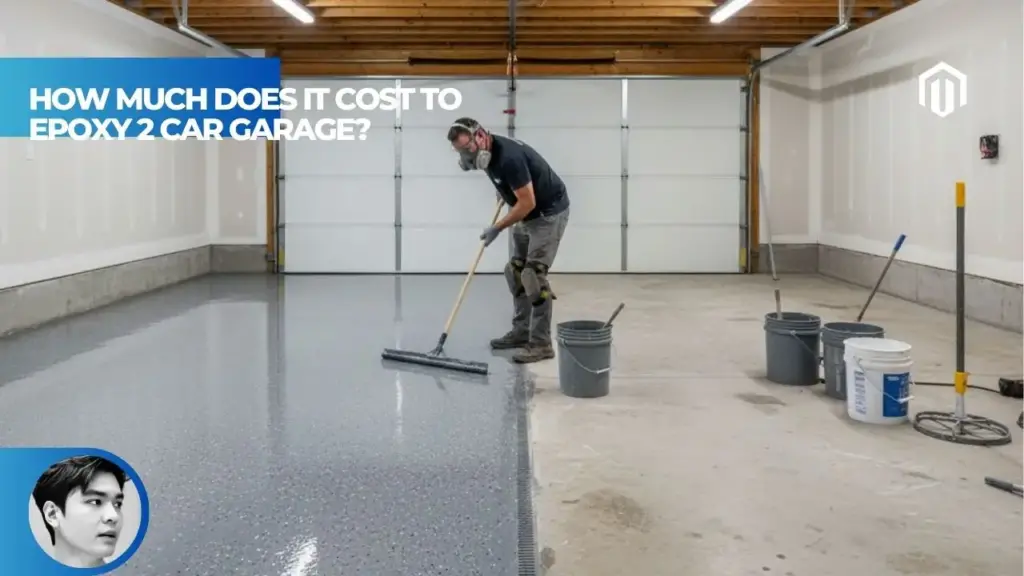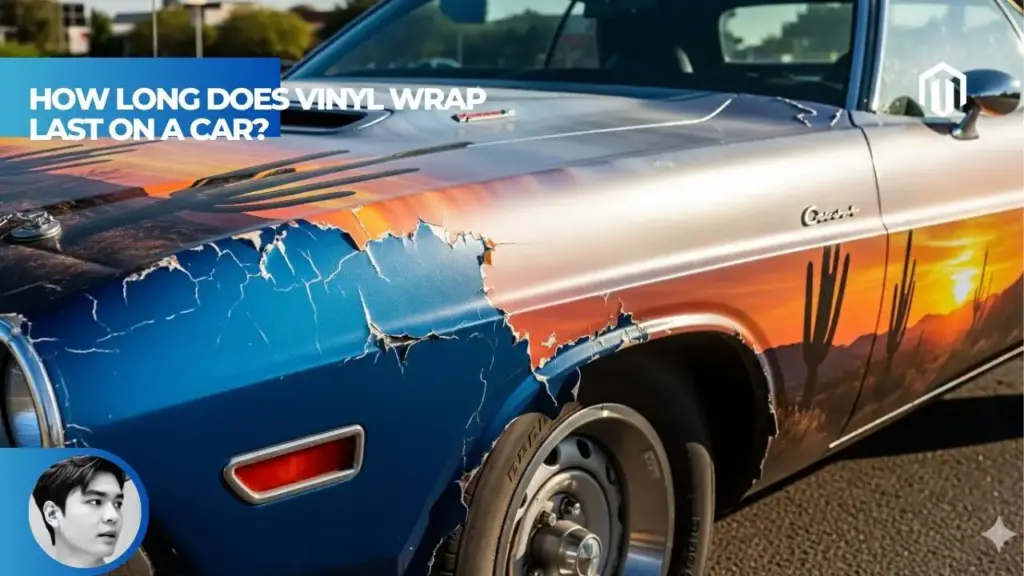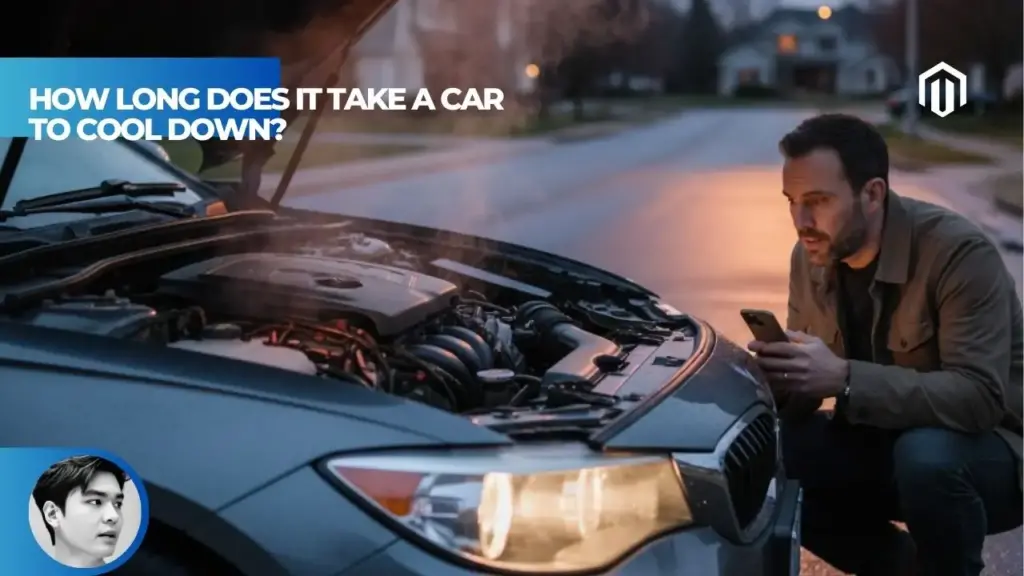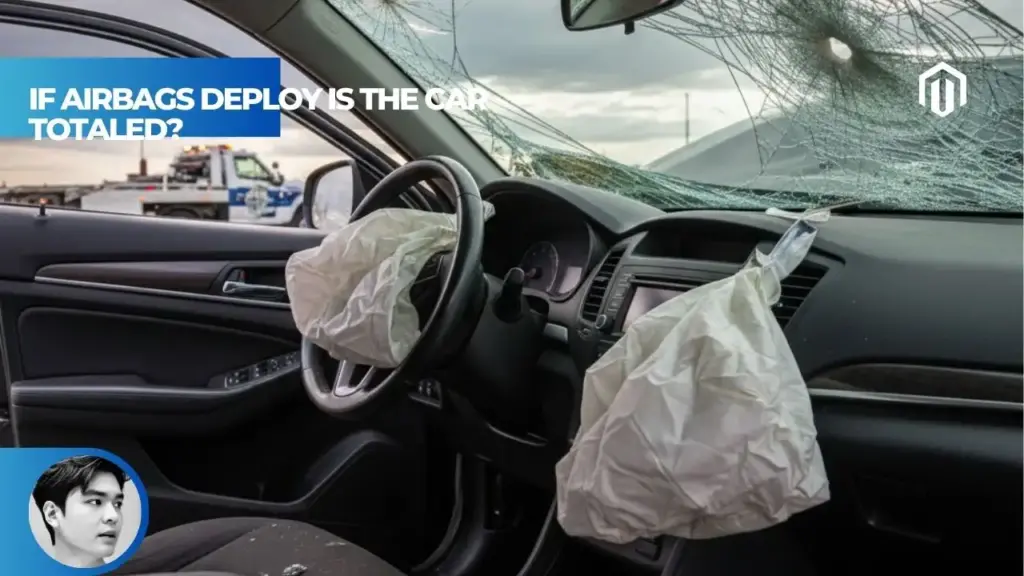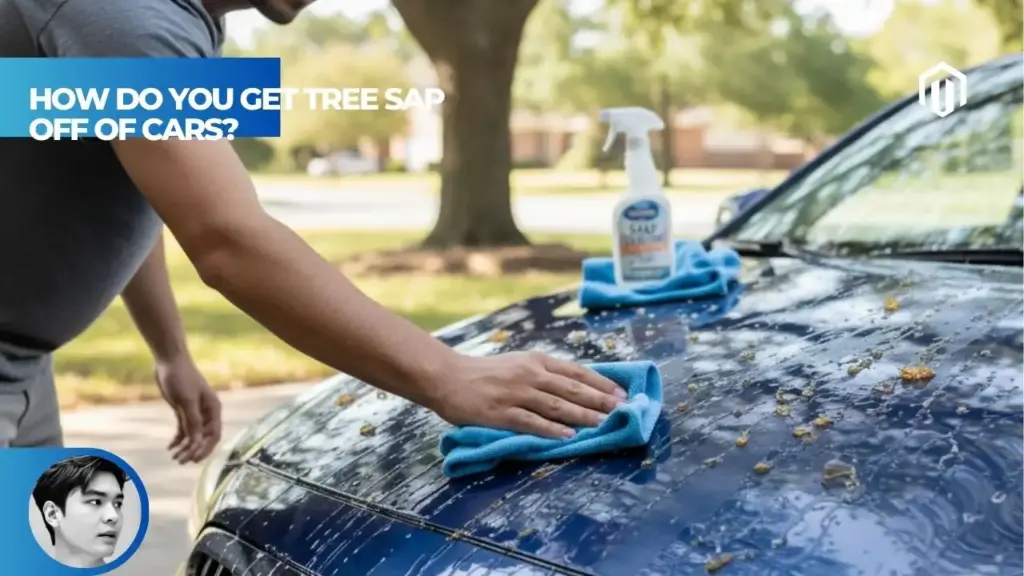You may also like:
- 【Explained】How to Get a Car with a Bad Fuel Pump to Start? (Temporary Hacks)
- 【Explained】How Many Gallons of Gas Does a Car Hold? (Understanding Average Fuel Tank Capacity)
- 【Explained】How to Fix an Audi Drive System Malfunction? A Step-by-Step Diagnostic Guide
- 【Explained】What Type of Gas Do BMW Take? Premium Fuel, Octane, and Knocking Explained
- 【Explained】What Gas Does the Civic Type R Take?
When your car smells like gas but isn’t leaking, the most common culprit is a malfunctioning EVAP (Evaporative Emissions) system that releases fuel vapors without any visible liquid fuel escape[1]. Unlike liquid fuel leaks that leave puddles under your vehicle, vapor leaks from damaged charcoal canisters, faulty purge valves, or loose gas caps create strong gasoline odors while evaporating instantly upon contact with air[2].
This invisible problem poses serious safety risks including fire hazards and health concerns from toxic fume inhalation. The EVAP system, designed to capture and store fuel vapors before routing them to the engine for combustion, can develop small cracks, loose connections, or component failures that allow vapors to escape without creating the wet spots typically associated with fuel leaks[3].
Temperature changes, internal fuel system problems, and even something as simple as an improperly tightened gas cap can cause these phantom fuel odors. Understanding the root causes helps identify whether you’re dealing with a minor issue like a loose gas cap or a more serious EVAP system failure requiring professional diagnosis and repair.

Understanding Gas Smells Without Visible Leaks
Why No Leak Doesn’t Mean No Problem
The absence of visible liquid fuel under your vehicle doesn’t eliminate the possibility of serious fuel system issues. Modern automotive fuel systems are complex closed-loop networks designed to contain both liquid gasoline and its vapors, making vapor-only leaks particularly challenging to detect[1].
Key differences between vapor and liquid fuel leaks:
| Leak Type | Visibility | Detection Method | Safety Risk Level |
|---|---|---|---|
| Liquid fuel leak | Visible puddles, wet spots | Visual inspection | High |
| Vapor leak | Invisible to naked eye | Professional smoke testing | Very High |
| Internal component leak | No external evidence | OBD-II scanning, performance monitoring | Moderate to High |
| Temperature-dependent leak | Intermittent, conditions-based | Temperature cycling tests | Variable |
- EVAP system failures represent the most common source of vapor-only leaks. This emissions control system captures gasoline vapors from the fuel tank and stores them in a charcoal canister until they can be burned in the engine during normal operation[2]. When components fail, vapors escape directly into the atmosphere rather than following their intended path.
- Temperature-dependent evaporation patterns create additional complexity in diagnosis. Fuel vapors become more volatile in warm weather, making leaks more noticeable during summer months. Conversely, cold weather can cause seals and hoses to contract, creating temporary gaps that seal when temperatures rise.
- Internal component issues like leaking fuel injectors or faulty fuel pressure regulators create rich fuel mixtures that produce strong gasoline odors through the exhaust system without any external fuel escape. These problems often coincide with performance issues like rough idling or poor acceleration.
Common Scenarios and When They Occur
Different gas smell patterns provide diagnostic clues about the underlying problem. Understanding when and where these odors appear helps narrow down potential causes and determine urgency levels[3].
Gas smell timing and location patterns:
- Startup odors – Often indicate EVAP purge valve problems or fuel system pressure issues
- AC/Heat activation smells – Suggest vapor infiltration into the cabin air system
- Post-refueling odors – Point to gas cap problems or overfilling issues
- Parking/idle smells – May indicate charcoal canister saturation or vent valve failures
Environmental factors affecting odor intensity:
| Condition | Impact on Smell | Primary Causes |
|---|---|---|
| Hot weather | Increased vapor production | Higher evaporation rates |
| Cold starts | More noticeable odors | System pressure changes |
| Humid conditions | Reduced vapor dispersion | Atmospheric pressure effects |
| Enclosed parking | Concentrated odor buildup | Poor ventilation |
Fuel quality considerations also affect odor patterns. Modern gasoline blends with ethanol can produce different vapor characteristics than traditional gasoline. Seasonal fuel formulations, particularly winter blends with higher vapor pressure, may create more noticeable odors when system failures occur.
Understanding how long does it take a car to cool down becomes relevant when diagnosing temperature-related vapor leaks, as cooling periods affect system pressure and component expansion rates.
Safety Risks and Health Concerns
Gasoline vapors present immediate and long-term dangers that extend far beyond the inconvenience of unpleasant odors. The invisible nature of vapor leaks often leads drivers to underestimate the severity of potential consequences[4].
Fire and explosion hazards:
- Vapor ignition temperature: 536°F (much lower than liquid gasoline)
- Explosive vapor concentration: 1.4-7.6% in air mixture
- Common ignition sources: Hot exhaust components, electrical sparks, static electricity
- Vapor accumulation: Heavier than air, collecting in low areas under vehicle
Health effects from gasoline vapor exposure:
| Exposure Duration | Immediate Effects | Long-term Consequences |
|---|---|---|
| Short-term (minutes) | Dizziness, headaches, nausea | Typically reversible |
| Medium-term (hours) | Eye/throat irritation, disorientation | Respiratory sensitivity |
| Long-term (chronic) | Central nervous system depression | Potential carcinogenic effects |
Toxic compound concentrations in gasoline vapors include benzene, toluene, and xylene – all classified as hazardous air pollutants by the EPA. Benzene exposure carries particular concern as a known human carcinogen linked to blood disorders and leukemia with prolonged exposure[4].
Emergency situations requiring immediate action:
- Strong persistent odors inside the vehicle cabin
- Vapor clouds visible around the vehicle
- Odors accompanied by engine performance problems
- Any combination of gas smells with electrical issues
Professional automotive safety experts recommend treating any gasoline odor as a potential emergency until the source is identified and eliminated. The invisible nature of vapor leaks makes them potentially more dangerous than visible liquid leaks due to the false sense of security they create.
Root Causes of Gas Smell Without Visible Leaking
EVAP System Malfunctions and Components
The Evaporative Emissions Control System represents the most sophisticated and failure-prone component related to fuel vapor management in modern vehicles. This complex network of interconnected parts works to prevent fuel vapors from entering the atmosphere while maintaining proper fuel system pressure[1].
Primary EVAP system components and failure modes:
| Component | Function | Common Failures | Symptoms |
|---|---|---|---|
| Charcoal Canister | Stores fuel vapors | Cracking, saturation, contamination | Strong fuel odors, P0441 codes |
| Purge Valve | Controls vapor flow to engine | Stuck open/closed, electrical failure | Rough idle, check engine light |
| Vent Valve | Manages tank pressure | Clogged, mechanically stuck | Difficulty fueling, tank deformation |
| Vacuum Lines | Connect system components | Cracking, disconnection, deterioration | Hissing sounds, intermittent odors |
- Charcoal canister saturation occurs when the activated carbon becomes overwhelmed with fuel vapors and can no longer absorb additional vapors effectively. This commonly happens in vehicles driven primarily for short distances where the purge cycle doesn’t operate long enough to clear stored vapors[2].
- Purge valve malfunctions create two distinct problem scenarios. When stuck open, the valve allows constant vapor flow to the engine, causing rich fuel mixtures and rough idling. When stuck closed, vapors accumulate in the system until they find alternative escape routes, often creating the gas smell without leak phenomenon.
- Vacuum line deterioration represents a particularly insidious problem because these small-diameter hoses develop hairline cracks that are invisible during casual inspection but large enough to allow significant vapor escape under system pressure.
- Electronic control failures in the EVAP system’s solenoids and sensors can prevent proper system operation even when all mechanical components remain intact. These failures often trigger diagnostic trouble codes while allowing continued vapor escape.
Fuel System Internal Problems
Internal fuel system components can develop leaks or malfunctions that create strong gasoline odors without any external fuel escape. These problems often coincide with engine performance issues, providing additional diagnostic clues[3].
Internal fuel system leak sources:
- Fuel injector seal failure – Creates rich cylinder conditions and exhaust odors
- Fuel pressure regulator malfunction – Causes over-pressurization and vapor escape
- Internal fuel pump issues – Allows vapors to bypass normal containment
- Fuel rail connection problems – Creates high-pressure vapor leaks under hood
Fuel injector problems manifest through multiple symptoms beyond odors. Leaking injectors create uneven fuel distribution between cylinders, leading to rough idling, misfiring, and elevated exhaust emissions. The excess fuel often evaporates before reaching the combustion chamber, creating strong vapor concentrations around the engine bay.
Pressure regulator failures disrupt the careful balance of fuel system pressure designed to prevent vapor lock while maintaining adequate fuel delivery. When regulators stick open, excess pressure forces fuel vapors through alternative pathways, often into the intake manifold where they create rich running conditions and strong odors.
Carbon canister saturation cycles occur when internal fuel system problems create excess vapor production beyond the EVAP system’s capacity to handle. This creates a cascade effect where multiple system components become overwhelmed, leading to widespread vapor escape.
Real-world case example: A 2018 Honda Accord owner experienced persistent gas smells despite no visible leaks. Professional diagnosis revealed a failed fuel pressure regulator that was forcing excess fuel into the intake manifold. The repair cost $340 including labor, resolving both the odor and accompanying rough idle symptoms.
Simple External Causes
Not all gas smells without visible leaks indicate serious mechanical problems. Several common external factors can create strong fuel odors while leaving no liquid evidence behind[5].
Most common simple causes:
| Cause | Detection Method | Fix Complexity | Typical Cost |
|---|---|---|---|
| Loose gas cap | Visual/auditory inspection | DIY-friendly | $15-30 |
| Overfilled tank | Recent fueling history review | Wait for consumption | $0 |
| Spilled fuel during refueling | Timing correlation with fill-ups | Clean and ventilate | $0 |
| External contamination | Location-based analysis | Wash and inspect | $5-20 |
- Gas cap seal deterioration represents the most frequently overlooked cause of phantom fuel odors. The rubber seal around the cap’s perimeter degrades over time due to temperature cycling and fuel exposure. Even slight seal compression loss allows vapor escape while maintaining enough seal integrity to prevent liquid leakage.
- Overfilling consequences extend beyond the immediate spill concerns. Modern fuel systems include complex vapor recovery systems that can become flooded when tanks are filled beyond their intended capacity. This flooding can temporarily disrupt EVAP system operation, creating vapor leaks that persist until the excess fuel is consumed through normal driving.
- Fuel station contamination occurs when vapor recovery systems at gas pumps malfunction, coating vehicle surfaces with fuel residue that evaporates slowly while creating persistent odors. This is particularly common at older gas stations with poorly maintained vapor recovery equipment.
- Temperature-related expansion of fuel and fuel system components can create temporary seal compromises that allow vapor escape without liquid leakage. These situations often resolve themselves as temperatures stabilize but can recur cyclically with weather changes.
Understanding these simple causes helps vehicle owners avoid unnecessary diagnostic expenses while ensuring serious problems receive appropriate attention. As automotive experts at Autvex frequently note, starting with the simplest explanations often leads to the quickest and most cost-effective solutions.
Step-by-Step Diagnosis Process
Initial Safety and Visual Inspection
Before beginning any diagnostic procedures, establishing safety protocols prevents potential ignition of fuel vapors during inspection. Professional technicians follow standardized safety procedures that DIY enthusiasts should adapt for home use[6].
Essential safety precautions:
- Ensure proper ventilation – Work outdoors or in well-ventilated areas only
- Eliminate ignition sources – No smoking, open flames, or spark-producing tools
- Allow engine cooling – Wait minimum 30 minutes after driving before inspection
- Wear appropriate protection – Safety glasses and nitrile gloves recommended
- Have fire extinguisher available – Class B fire extinguisher within reach
Systematic visual inspection checklist:
| Inspection Area | What to Look For | Tools Needed |
|---|---|---|
| Gas cap area | Seal condition, proper threading, clicking sounds | Visual only |
| Fuel lines | Cracking, wetness, discoloration, connection tightness | Flashlight |
| EVAP components | Visible damage to canisters, loose vacuum lines | Flashlight, mirror |
| Engine bay | Fuel rail connections, injector seals, pressure regulator | Flashlight |
- Gas cap inspection techniques require more than casual observation. Remove the cap completely and examine the rubber seal for cracks, hardening, or deformation. When reinstalling, listen for distinct clicking sounds that indicate proper threading and sealing engagement. A properly installed gas cap should require significant force to remove.
- Fuel line assessment focuses on areas where lines bend, connect to components, or pass through heat sources. Look for darkening, swelling, or surface cracking that indicates deterioration. Pay particular attention to connections where clamps may have loosened due to thermal cycling.
- Component-specific inspection of EVAP system parts requires locating the charcoal canister (usually near the fuel tank), purge valve (often near the engine), and associated vacuum lines. Look for obvious damage, disconnected lines, or debris accumulation around components.
- Documentation importance cannot be overstated during initial inspection. Photograph any suspicious areas and note odor intensity in different vehicle locations. This documentation proves valuable when communicating with professional technicians or tracking problem progression.
EVAP System Testing Methods
Professional EVAP system diagnosis requires specialized equipment, but several testing methods provide valuable information for initial assessment. Understanding these procedures helps communicate effectively with repair technicians and evaluate diagnostic quality[7].
OBD-II scanner diagnostics:
- P0440 – EVAP system malfunction (general)
- P0441 – EVAP system incorrect purge flow
- P0442 – EVAP system leak detected (small leak)
- P0456 – EVAP system leak detected (very small leak)
- P0455 – EVAP system leak detected (gross leak)
Smoke testing procedures represent the gold standard for EVAP leak detection. Professional smoke machines introduce non-toxic vapor into the sealed fuel system under slight pressure. Leaks become visible as smoke escapes from damaged components or connections[7].
Pressure testing methodology:
| Test Type | Pressure Range | Duration | Leak Threshold |
|---|---|---|---|
| Gross leak test | 14-17 inches H2O | 2 minutes | >0.090″ diameter |
| Small leak test | 7-10 inches H2O | 2 minutes | 0.040″-0.090″ diameter |
| Very small leak test | 1-3 inches H2O | 2 minutes | 0.020″-0.040″ diameter |
- Component-specific testing involves isolating individual EVAP system parts to identify failure locations. Purge valves can be tested using vacuum pumps and multimeters to verify both mechanical seal integrity and electrical operation. Vent valves require similar testing to ensure proper opening and closing under controlled conditions.
- Fuel trim monitoring provides indirect EVAP system assessment by measuring how much the engine management system adjusts fuel delivery to maintain proper air-fuel ratios. Abnormal fuel trim values often indicate vapor leaks affecting combustion efficiency.
- Professional diagnostic timeline typically requires 1-2 hours for complete EVAP system assessment, including initial scanning, smoke testing, and component verification. This investment in thorough diagnosis prevents misdiagnosis and unnecessary part replacement.
Professional Diagnostic Tools and Techniques
Advanced diagnostic equipment enables precise identification of EVAP system problems that remain invisible to basic testing methods. Understanding these professional capabilities helps vehicle owners make informed decisions about repair approaches[8].
Essential professional diagnostic equipment:
- Automotive smoke machine ($300-1,500) – Creates visible vapor for leak detection
- Professional OBD-II scanner ($200-2,000) – Advanced data streaming and component activation
- Digital pressure/vacuum gauge ($50-200) – Precise system pressure measurement
- Ultrasonic leak detector ($150-500) – Detects high-frequency sounds from vapor escape
Advanced smoke testing protocols go beyond basic vapor introduction. Professional technicians use specific pressure levels, vapor concentrations, and testing durations to identify leaks as small as 0.020 inches in diameter. Different smoke types and pressures help distinguish between various leak sizes and locations.
EVAP leak detection pump operation in newer vehicles provides built-in diagnostic capabilities. These pumps periodically test system integrity by creating vacuum conditions and monitoring pressure decay rates. Understanding this system helps interpret diagnostic codes and system behavior.
Fuel trim analysis requires expertise in interpreting short-term and long-term fuel trim values across different engine operating conditions. Professional technicians use this data to identify vapor leaks affecting engine performance and emissions compliance.
The diagnostic process complexity explains why professional assessment often proves more cost-effective than DIY trial-and-error approaches. Quality diagnosis prevents unnecessary part replacement while ensuring proper repair of actual problems.
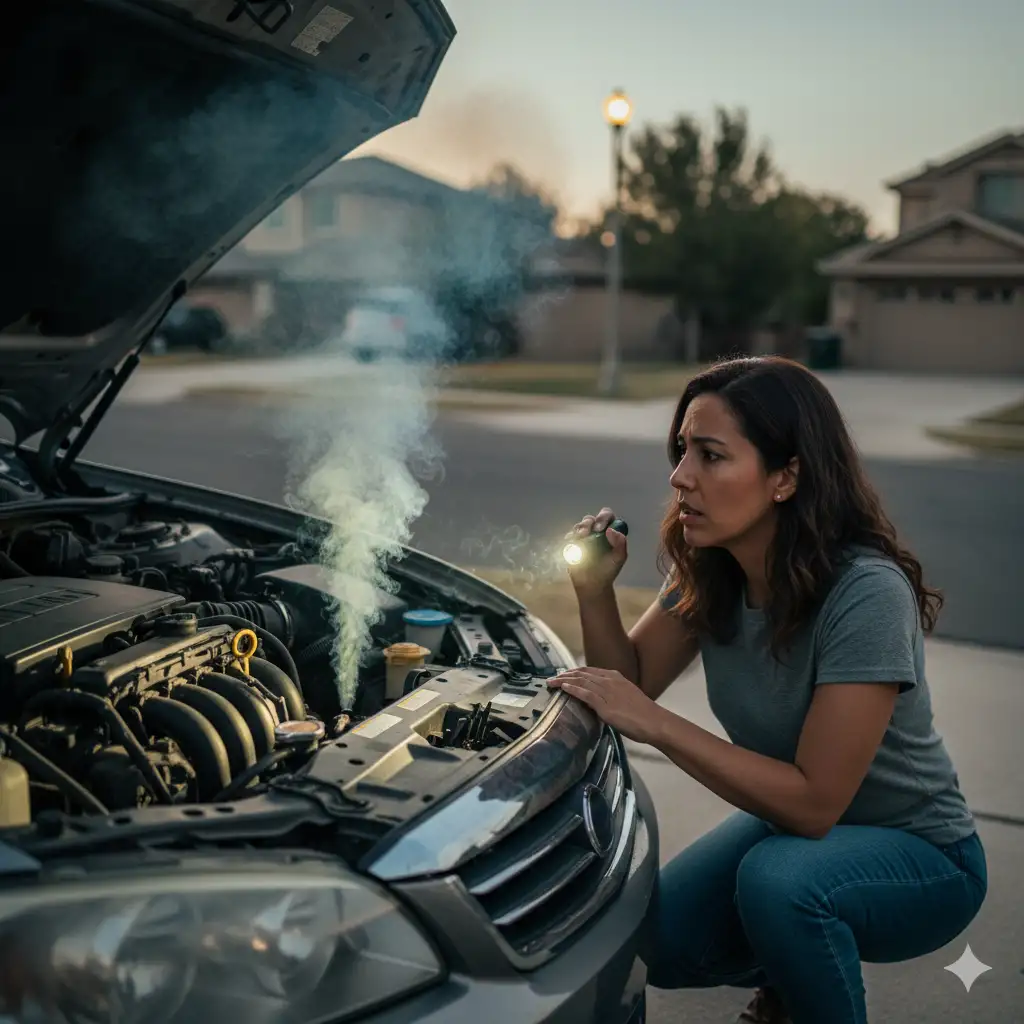
DIY vs Professional Repair Solutions
Simple Fixes You Can Handle
Several common causes of gas smells without visible leaks fall within the capability range of average vehicle owners. These DIY-appropriate repairs can save significant money while providing valuable learning experiences[5].
DIY-appropriate repairs and difficulty levels:
| Repair | Skill Level | Time Required | Tool Requirements | Success Rate |
|---|---|---|---|---|
| Gas cap replacement | Beginner | 5 minutes | None | 95% |
| Tightening loose connections | Beginner | 15-30 minutes | Basic hand tools | 80% |
| EVAP line visual inspection | Intermediate | 30-60 minutes | Flashlight, mirrors | 60% |
| Vacuum line replacement | Intermediate | 1-2 hours | Basic tools, replacement hoses | 70% |
- Gas cap replacement procedure represents the most straightforward DIY repair. Purchase the exact replacement part using your vehicle’s VIN number to ensure proper fit. Remove the old cap by turning counterclockwise, install the new cap by turning clockwise until you hear clicking sounds, then test by attempting to remove – it should require significant force.
- Connection tightening techniques require identifying specific connection types throughout the fuel system. Hose clamps use screwdrivers or nut drivers for adjustment, while push-on connections may need complete disconnection and reconnection to restore proper seal integrity. Always work with a cool engine and good ventilation.
- Visual inspection capabilities enable DIY diagnosis of many EVAP system problems. Use flashlights and inspection mirrors to examine hard-to-reach areas around the fuel tank and engine bay. Look for obvious damage, disconnected lines, or debris accumulation around system components.
When DIY approaches are appropriate:
- Obvious problems like loose gas caps or disconnected vacuum lines
- Recent changes that correlate with problem onset
- Simple visual inspection reveals clear damage
- Vehicle remains safe to drive without immediate professional attention
Safety considerations must take priority over cost savings. If vapor odors persist after simple repairs, or if any electrical components appear damaged, professional diagnosis becomes necessary to prevent safety hazards.
Professional Repair Requirements
Complex EVAP system repairs require specialized knowledge, equipment, and experience that exceed typical DIY capabilities. Understanding professional repair requirements helps set appropriate expectations for costs and timelines[8].
Professional repair scenarios and typical costs:
| Repair Type | Labor Time | Parts Cost | Total Cost Range | Warranty Period |
|---|---|---|---|---|
| Charcoal canister replacement | 2-4 hours | $150-400 | $350-800 | 12-24 months |
| Purge valve replacement | 1-2 hours | $50-150 | $150-350 | 12 months |
| Complete EVAP system overhaul | 4-8 hours | $300-800 | $800-1,600 | 12-24 months |
| Fuel injector service | 3-5 hours | $200-600 | $500-1,200 | 6-12 months |
- EVAP system component replacement often requires specialized tools for accessing components in confined spaces near fuel tanks. Professional technicians use proper lifting equipment, fuel system pressure relief procedures, and contamination prevention measures during repairs.
- Diagnostic verification following repairs ensures problem resolution and prevents comeback issues. Professional shops use the same diagnostic equipment employed during initial assessment to confirm proper system operation and absence of remaining leaks.
- Fuel system cleaning procedures may be necessary when contamination accompanies EVAP system failures. Carbon buildup, fuel varnish, or debris accumulation can prevent proper system operation even after component replacement.
Professional repair advantages include warranty coverage, proper diagnostic verification, and prevention of additional problems through comprehensive system assessment. Quality shops provide detailed explanations of repair necessity and post-repair testing procedures.
Warranty and Insurance Considerations
Understanding warranty coverage and insurance implications helps make informed decisions about repair approaches while minimizing out-of-pocket expenses. Different coverage types apply to various scenarios[9].
Warranty coverage scenarios:
- Manufacturer powertrain warranty – May cover EVAP system components for 8 years/80,000 miles
- Extended service contracts – Often include emissions-related component coverage
- Component manufacturer warranties – Apply to replacement parts regardless of installation location
- Repair shop warranties – Guarantee workmanship and parts for specified periods
Insurance coverage considerations typically exclude mechanical failures but may cover damage resulting from accidents or covered perils. Some comprehensive coverage policies include provisions for emissions system repairs required to maintain legal vehicle operation.
Documentation requirements for warranty claims include maintenance records, diagnostic reports, and proof of qualified repair facility use. Maintaining detailed service records proves particularly valuable for emissions-related warranty claims that require evidence of proper maintenance.
Understanding what happens when your car is totaled but still drivable becomes relevant when EVAP system repair costs approach significant percentages of vehicle value, particularly in older vehicles where coverage may be limited.
Cost-benefit analysis should consider vehicle age, mileage, overall condition, and repair costs when deciding between professional repair, DIY attempts, or vehicle replacement. Professional assessment often provides the information necessary for informed decision-making.
Immediate Actions and Safety Protocols
What to Do When You First Smell Gas
The moment you detect gasoline odors in or around your vehicle, immediate action becomes critical for safety. Professional emergency response protocols adapted for civilian use provide structured approaches to minimize risks while addressing the underlying problem[4].
Immediate response priority sequence:
- Stop driving safely – Pull over in well-ventilated area away from traffic
- Turn off engine – Eliminate ignition sources immediately
- Exit vehicle – Move to safe distance (minimum 25 feet upwind)
- Assess odor intensity – Determine if professional help needed immediately
- Ventilate area – Open vehicle doors and windows if safe to do so
Emergency contact decision matrix:
| Situation | Immediate Action | Contact Priority |
|---|---|---|
| Strong persistent cabin odors | Evacuate vehicle immediately | Emergency services |
| Visible vapor clouds | Evacuate area, prevent ignition | Emergency services |
| Mild intermittent odors | Safe ventilation, monitor | Professional diagnosis within 24 hours |
| Post-refueling odors only | Check gas cap, wait 10 minutes | Self-assessment, then professional if persistent |
Safety zone establishment requires understanding vapor behavior and wind patterns. Gasoline vapors are heavier than air and accumulate in low areas, making it essential to move upwind and uphill from the vehicle when possible. Avoid enclosed spaces like garages or underpasses where vapors can concentrate.
Initial assessment questions help determine urgency levels:
- How long have odors been present?
- Do odors occur consistently or only under specific conditions?
- Are there any accompanying performance problems?
- Has anything changed recently (repairs, refueling practices, parking locations)?
Documentation during emergency response includes photographing instrument panel warnings, noting exact symptoms and timing, and recording environmental conditions. This information proves valuable for subsequent professional diagnosis and potential insurance claims.
Communication with emergency services should include vehicle location, number of people affected, wind direction, and any visible vapor or liquid fuel. Emergency responders can provide guidance about safe waiting distances and whether professional hazmat response is necessary.
Temporary Solutions and Workarounds
When immediate professional repair isn’t available, specific temporary measures can reduce risks while maintaining essential vehicle operation. These workarounds should never replace proper repairs but can provide short-term safety improvements[10].
Safe driving practices with known fuel system problems:
- Maintain maximum ventilation – Keep windows cracked open during operation
- Avoid enclosed spaces – Park outdoors, avoid garages and parking structures
- Monitor odor changes – Stop immediately if smells intensify
- Limit trip duration – Make only essential trips until repair completion
- Carry fire extinguisher – Class B extinguisher appropriate for liquid fuel fires
Ventilation strategies by scenario:
| Driving Condition | Window Setting | AC/Heat Setting | Monitoring Frequency |
|---|---|---|---|
| Highway driving | Slightly cracked | Fresh air mode | Every 15 minutes |
| City driving | Fully cracked | Fresh air mode | Every 10 minutes |
| Stop-and-go traffic | Fully open if safe | Off or fresh air only | Continuous |
| Parking | Fully open | Off | Before re-entry |
- Gas cap temporary repairs can sometimes provide short-term odor reduction. Clean the cap threads and sealing surface with soap and water, then apply a thin layer of petroleum jelly to the rubber seal. This temporary measure may improve sealing until replacement parts arrive.
- Monitoring for worsening conditions requires systematic attention to odor patterns, engine performance, and fuel consumption changes. Document any increases in odor intensity, new performance problems, or unusual fuel consumption patterns that might indicate problem progression.
- When temporary measures are insufficient includes any situation where odors persist inside the vehicle cabin despite maximum ventilation, worsen over time, or accompany engine performance problems. These scenarios require immediate professional attention regardless of convenience factors.
Professional automotive experts emphasize that temporary workarounds should never exceed 2-3 days duration and must be accompanied by arrangements for professional diagnosis and repair.
Warning Signs Requiring Immediate Professional Help
Certain combinations of symptoms indicate serious safety risks that require immediate professional intervention. Recognition of these warning signs prevents potential catastrophic failures and protects both vehicle occupants and surrounding people[11].
Critical warning sign combinations:
- Strong cabin odors + check engine light – Indicates major system failure
- Gas smell + rough idle/misfiring – Suggests internal fuel system problems
- Vapor odors + electrical burning smells – Potential ignition source near fuel vapors
- Persistent odors + visible staining – Indicates multiple failure points
Performance symptoms requiring immediate attention:
| Symptom | Urgency Level | Likely Cause | Action Required |
|---|---|---|---|
| Engine won’t start + gas smell | Emergency | Flooded engine or major leak | Professional immediately |
| Rough idle + strong odors | High | Internal fuel system failure | Professional within hours |
| Check engine light + mild odors | Moderate | EVAP system problem | Professional within 24 hours |
| Intermittent odors only | Low | Minor EVAP leak | Professional within 1 week |
- Electrical system warning signs include any combination of fuel odors with electrical problems like blown fuses, flickering lights, or burning electrical smells. These combinations create extremely dangerous conditions where fuel vapors and potential ignition sources coexist.
- Progressive symptom patterns often indicate deteriorating problems that will worsen without intervention. Odors that become stronger over time, occur more frequently, or begin affecting vehicle performance require accelerated professional attention to prevent complete system failure.
- Environmental hazard indicators include situations where vapor odors affect other people in parking areas, garages, or during vehicle operation. Legal liability and environmental regulations require prompt attention to vapor emissions that affect air quality or public safety.
- Professional diagnostic services become essential when multiple systems show problems simultaneously, when safety risks exceed acceptable levels, or when DIY assessment reveals complex problems requiring specialized equipment or expertise.
Understanding these warning signs helps prioritize repair urgency while avoiding unnecessary emergency service calls for minor problems that can wait for regular professional attention.
Prevention and Long-Term Maintenance
Regular Fuel System Maintenance
Proactive maintenance prevents most fuel system problems while extending component life and maintaining optimal vehicle performance. Professional maintenance schedules adapted for owner implementation provide cost-effective prevention strategies[12].
Recommended fuel system maintenance intervals:
| Component/Service | Interval | DIY Feasibility | Professional Cost | DIY Cost |
|---|---|---|---|---|
| Gas cap inspection | Monthly | Easy | N/A | Free |
| Fuel system cleaner | Every 10,000 miles | Easy | $50-80 | $15-25 |
| EVAP system inspection | Annually | Moderate | $100-150 | $20-40 |
| Fuel filter replacement | 30,000-60,000 miles | Difficult | $150-250 | $40-80 |
- EVAP system preventive care focuses on keeping components clean and connections secure. Monthly visual inspections of accessible vacuum lines and connections prevent small problems from developing into major failures. Look for loose clamps, cracked hoses, or debris accumulation around system components.
- Fuel quality considerations significantly impact system longevity. Using Top Tier gasoline brands with proper detergent packages helps prevent fuel system contamination and deposit formation. Avoid fueling at stations with obvious maintenance problems or frequently busy locations where fuel turnover ensures freshness.
- Seasonal maintenance adjustments account for temperature-related expansion and contraction of fuel system components. Spring inspections should focus on winter damage from road salt and temperature cycling, while fall preparations ensure proper sealing before cold weather stress.
- Component lifecycle planning helps budget for predictable maintenance needs. Fuel caps typically last 5-7 years, while EVAP system components like charcoal canisters may require replacement every 8-10 years depending on driving patterns and maintenance quality.
Professional maintenance records prove valuable for warranty claims and resale value. Document all fuel system services, including dates, mileage, and specific work performed to demonstrate proper care and maintenance compliance.
Proper Refueling Habits and Practices
Correct refueling techniques prevent many fuel system problems while maximizing safety and system longevity. Understanding proper procedures helps avoid common mistakes that cause EVAP system damage and vapor leaks[13].
Optimal refueling procedures:
- Turn off engine completely – Eliminate ignition sources during fuel handling
- Remove gas cap slowly – Allow pressure equalization before full removal
- Insert nozzle fully – Ensure proper seal for vapor recovery systems
- Stop at automatic shutoff – Never override pump automatic stop mechanism
- Replace cap properly – Turn until clicking sounds indicate proper sealing
Overfilling prevention strategies require understanding automatic shutoff mechanisms and resisting the temptation to “top off” the tank. Overfilling can flood EVAP system components with liquid fuel, causing permanent damage and vapor leaks that persist long after the excess fuel is consumed.
Gas cap maintenance routine:
- Clean threads monthly with damp cloth to prevent binding
- Inspect seal condition during each fuel stop for cracks or deformation
- Listen for clicking sounds during installation to verify proper engagement
- Replace every 5-7 years regardless of apparent condition
Fuel quality selection impacts both performance and system longevity. Choose Top Tier gasoline brands when possible, as these fuels contain detergent packages that help prevent fuel system contamination. Avoid discount fuels from stations with obvious maintenance problems or low turnover rates.
Environmental considerations during refueling include wind direction, temperature, and proximity to ignition sources. Avoid refueling during electrical storms, in enclosed spaces, or when strong winds might concentrate vapors in dangerous locations.
Understanding proper refueling techniques prevents many problems that lead to expensive repairs. As Autvex automotive experts frequently emphasize, prevention through proper practices costs significantly less than correction through professional repair.
Early Warning Sign Recognition
Developing sensitivity to subtle changes in vehicle behavior enables early problem detection when repairs remain simple and inexpensive. Professional diagnostic experience adapted for owner use provides systematic approaches to identifying developing problems[14].
Progressive symptom recognition patterns:
| Warning Level | Symptoms | Timeline | Action Required |
|---|---|---|---|
| Early | Occasional faint odors after refueling | 1-2 weeks | Monitor and document |
| Developing | Odors present during specific conditions | 2-4 weeks | Schedule inspection |
| Advanced | Consistent odors with performance changes | Immediate | Professional diagnosis |
| Critical | Strong cabin odors or safety concerns | Immediate | Emergency response |
- Fuel system performance indicators often provide earlier warning than obvious odor problems. Monitor fuel economy changes, engine performance variations, and unusual operating characteristics that might indicate developing fuel system problems.
- Seasonal monitoring adjustments account for temperature-related changes in fuel system behavior. Spring warming may reveal winter damage, while fall cooling can expose seal problems that remained hidden during warm weather. Adjust monitoring frequency based on seasonal transition periods.
- Documentation techniques for early warning signs include maintaining a simple log of fuel economy, odor occurrences, and performance observations. Digital photos of instrument panel displays during unusual conditions provide valuable diagnostic information for professional technicians.
- Check engine light pattern recognition helps distinguish between minor emissions problems and serious safety issues. Solid check engine lights often indicate less urgent problems, while flashing lights suggest immediate attention requirements.
- Environmental trigger identification involves noting conditions that produce or worsen symptoms. Temperature, humidity, driving patterns, and fuel sources may all influence problem manifestation and help identify root causes.
Systematic attention to early warning signs prevents most major fuel system failures while maintaining vehicle safety and reliability. Early intervention typically costs significantly less than emergency repairs while avoiding potential safety hazards.
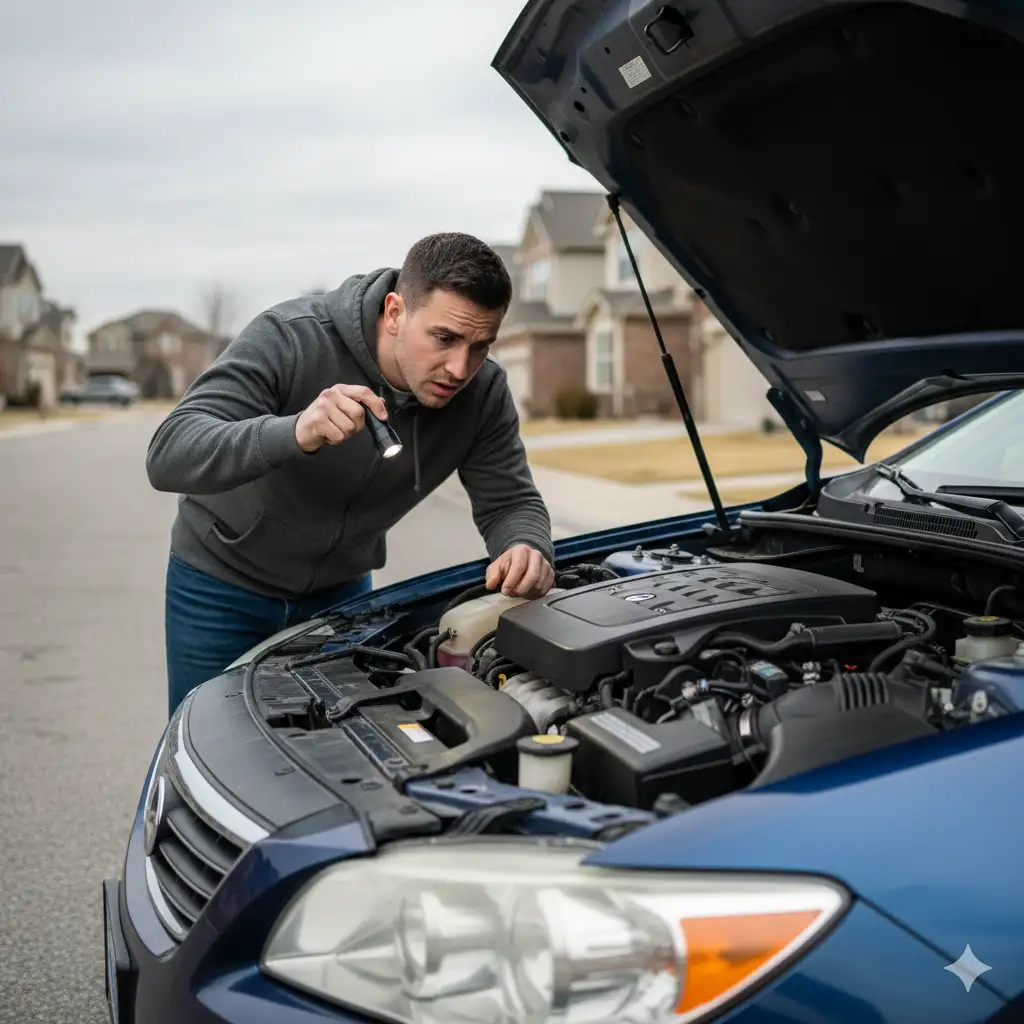
Key Takeaways
- EVAP system failures cause most gas smells without visible leaks – Cracked charcoal canisters, faulty purge valves, or damaged vacuum lines release fuel vapors that evaporate instantly, creating strong odors without puddles
- Safety risks are serious even without visible fuel – Gasoline vapors are more flammable than liquid fuel and pose fire, explosion, and health hazards from toxic compound exposure including benzene and other carcinogens
- Simple causes like loose gas caps should be checked first – Gas cap seal problems account for nearly 30% of vapor leak cases and can be fixed for under $30, making this the most cost-effective starting point
- Professional diagnosis prevents costly misrepairs – EVAP system problems require specialized smoke testing equipment to locate invisible leaks, making professional assessment more economical than trial-and-error part replacement
- Immediate action is required for strong persistent odors – Any gas smell inside the vehicle cabin or persistent outdoor odors require stopping driving and seeking professional help within 24 hours to prevent safety hazards
- Preventive maintenance saves money and prevents problems – Monthly gas cap inspections, proper refueling habits, and annual EVAP system checks cost significantly less than emergency repairs and prevent most vapor leak issues
- Early warning sign recognition enables cheaper repairs – Monitoring fuel economy changes, performance variations, and seasonal odor patterns allows problem identification when repairs remain simple and inexpensive rather than complex system overhauls
Frequently Asked Questions
Is it dangerous to drive when my car smells like gas?
Yes, driving with gas smells is inherently dangerous due to fire and explosion risks from fuel vapors. Gasoline vapors are more flammable than liquid gasoline and can ignite from hot exhaust components, electrical sparks, or static electricity[4]. If you detect strong or persistent odors, especially inside the cabin, stop driving immediately and seek professional diagnosis within 24 hours.
What does a bad EVAP system smell like?
A failing EVAP system typically produces a distinct raw gasoline odor that may be strongest when starting the vehicle, during refueling, or when the AC/heat is operating. The smell is usually more noticeable in warm weather and may vary in intensity based on fuel tank level and recent driving conditions[1]. Unlike liquid fuel leaks, EVAP system odors rarely leave visible evidence under the vehicle.
Can a loose gas cap cause gas smell inside the car?
Yes, a loose or damaged gas cap is one of the most common causes of gas smells without visible leaks. The gas cap seal prevents fuel vapors from escaping the fuel system, and when it fails, vapors can enter the vehicle’s ventilation system through various pathways[5]. This problem costs only $15-30 to fix and should be checked first before pursuing more expensive diagnostic procedures.
How much does it cost to fix an EVAP leak?
EVAP leak repair costs vary significantly depending on the failed component and labor requirements. Simple fixes like gas cap replacement cost $15-30, while purge valve replacement ranges from $150-350. Complete charcoal canister replacement can cost $350-800, and comprehensive EVAP system overhauls may reach $800-1,600[8]. Professional diagnosis typically costs $100-150 but prevents unnecessary part replacement.
Why does my car smell like gas only when the AC is on?
Gas smells when using AC often indicate that fuel vapors are entering the vehicle’s ventilation system through a compromised EVAP system or fuel system leak. The AC system’s fresh air intake can draw vapor-contaminated air from the engine compartment or undercarriage areas into the cabin[10]. This requires immediate professional attention as it indicates vapors are accumulating near the vehicle’s air intake systems.
Can overfilling my gas tank cause gas smell?
Yes, overfilling the gas tank can cause temporary gas smells by flooding EVAP system components with liquid fuel instead of just vapors. This can saturate the charcoal canister and cause vapor escape until the excess fuel is consumed through normal driving[13]. Always stop fueling when the pump automatically shuts off and never attempt to “top off” the tank past this point.
What trouble codes indicate EVAP system problems?
Common EVAP system diagnostic codes include P0440 (general system malfunction), P0441 (incorrect purge flow), P0442 (small leak detected), P0455 (gross leak detected), and P0456 (very small leak detected)[7]. These codes help technicians narrow down problem areas but require professional smoke testing or pressure testing to pinpoint exact leak locations within the complex EVAP system network.
How long can I drive with a gas smell before it’s unsafe?
You should not drive any distance with strong or persistent gas smells, especially if odors are present inside the vehicle cabin. For mild, intermittent odors that occur only under specific conditions, limit driving to essential trips only while maintaining maximum ventilation until professional diagnosis can be completed within 24-48 hours[4]. Any worsening of symptoms requires immediate cessation of driving.
Will a gas smell go away on its own?
Gas smells rarely resolve themselves and typically indicate mechanical problems requiring repair. While temporary odors from overfilling or external contamination may fade as excess fuel evaporates, persistent odors usually indicate component failures that will worsen over time[11]. Hoping problems will resolve naturally often leads to more expensive repairs and continued safety risks.
What’s the difference between gas smell from exhaust vs fuel system?
Exhaust-related gas smells typically occur during engine operation and may be accompanied by visible smoke or performance problems like rough idling. Fuel system gas smells are usually strongest when the vehicle is parked, recently refueled, or during initial startup[3]. Exhaust odors often indicate internal engine problems like leaking fuel injectors, while fuel system odors typically point to EVAP system failures or external leaks. Professional diagnosis can distinguish between these sources through systematic testing procedures.
References
- Innova. (2023, December 25). Common Symptoms Of The Faulty Evaporative (EVAP) Emission Control System. https://www.innova.com/blogs/fix-advices/common-symptoms-of-the-faulty-evaporative-evap-emission-control-system
- Summer’s Automotive. (2022, July 14). Common Causes of Car Evap System Failure. https://www.summersautomotive.com/common-causes-of-car-evap-system-failure/
- JB Tools. (2025, September 20). What Is an EVAP System Leak and How To Diagnose? https://www.jbtools.com/blog/what-is-an-evap-system-leak-and-how-to-diagnose/
- DDPAI. (2025, July 2). Why Does My Car Smell Like Gas? https://www.ddpai.com/blog/why-does-my-car-smell-like-gas/
- Burt Brothers. (2025, July 8). Gas Smell Inside Your Car? What It Means & How to Fix It. https://burtbrothers.com/tips/gas-smell-inside-your-car-what-it-means-how-to-fix-it/
- Auto Haus Dierolf. (2025, April 14). Understanding Your Car’s EVAP System and Why It’s Important. https://www.autohausdierolf.com/blog/understanding-your-cars-evap-system-and-why-its-important/
- Autool Tech. (2025, August 30). Everything You Need to Know About EVAP System Leak. https://shop.autooltech.com/2025/08/31/everything-you-need-to-know-about-evap-system-leak/
- Destin Auto Center. (2025, June 26). What Happens When There Is a Leak in the EVAP System of Your Vehicle. https://www.autoworksofdestin.com/what-happens-when-there-is-a-leak-in-the-evap-system-of-your-vehicle
- Edmunds. (2024, November 11). P0440: Evaporative Emission Control System Malfunction. https://www.edmunds.com/obd-dtc/p0440.html
- Urb’s Garage. (2025, May 18). Why Do I Smell Gas in My Car When the AC Is On. https://urbsgarage.com/why-do-i-smell-gas-in-my-car-when-the-ac-is-on/
- Merrill Auto. (2025, August 13). Can You Safely Drive With an EVAP Leak? https://merrillauto.com/blog/can-you-safely-drive-evap-leak/
- Olympia Auto Works. (2024, December 10). Understanding EVAP Leaks and How to Fix Them. https://www.olympiaautoworks.com/understanding-and-fix-evap-leaks/
- Ancel. (2025, April 16). How to Fix a Leak in the EVAP System. https://www.ancel.com/blogs/news/fix-evap-system-leak
- AutoNation Mobile Service. (2025, June 25). Symptoms of a Bad Purge Valve: 8 Critical Signs + Fixes. https://www.autonationmobileservice.com/i/blog/symptoms-bad-purge-valve/

I am a senior automotive analyst at Autvex. Expert vehicle evaluations, in-depth reviews, and objective analysis helping readers make informed automotive decisions with years of industry experience.


